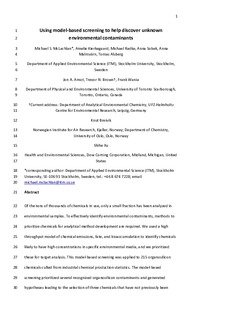| dc.identifier.citation | McLachlan, M.S., Kierkegaard, A., Radke, M., Sobek, A., Malmvärn, A., Alsberg, T., Arnot, J.A., Brown, T.N., Wania, F., Breivik, K., Xu, S. (2014). Using model-based screening to help discover unknown environmental contaminants. Environmental Science and Technology, 48, 7264-7271. doi: 10.1021/es5010544 | nb_NO |
| dc.description.abstract | Of the tens of thousands of chemicals in use, only a small fraction has been analyzed in environmental samples. To effectively identify environmental contaminants, methods to prioritize chemicals for analytical method development are required. We used a high throughput model of chemical emissions, fate, and bioaccumulation to identify chemicals likely to have high concentrations in specific environmental media, and we prioritized these for target analysis. This model-based screening was applied to 215 organosilicon chemicals culled from industrial chemical production statistics. The model-based screening prioritized several recognized organosilicon contaminants and generated hypotheses leading to the selection of three chemicals that have not previously been identified as potential environmental contaminants for target analysis. Trace analytical methods were developed and the chemicals were analyzed in air, sewage sludge, and sediment. All three substances were found to be environmental contaminants. Phenyl-tris(trimethylsiloxy)silane was present in all samples analyzed, with concentrations of ~50 pg m-3 in Stockholm air and ~0.5 ng g-1 dw in sediment from the Stockholm archipelago. Tris(trifluoropropyl)trimethyl-cyclotrisiloxane and tetrakis(trifluoropropyl)tetramethyl-cyclotetrasiloxane were found in sediments from Lake Mjøsa at ~1 ng g-1 dw. The discovery of three novel environmental contaminants shows that models can be useful for prioritizing chemicals for exploratory assessment. | nb_NO |
